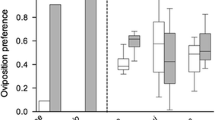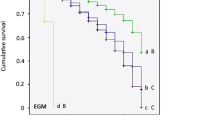Abstract
Feeding preferences in naive first instar and penultimate-final instar bagworm (Thyridopteryx ephemeraeformis)larvae were investigated using two choice tests. Naive first instar larvae showed a general (though not exclusive) preference for black willow (Salix nigra)over other hosts tested, regardless of the host of origin. Penultimate-final instar larvae showed strong preferences for the previous rearing host, suggesting induction of host preference; there was no evidence of host origin effects. The ability to discriminate among hosts is important if it is actually used to make host choices based on host quality. In bagworms, where host choices (if any) must be made by larvae in habitats where several hosts are often present, host discriminatory ability is likely important.
Similar content being viewed by others
References
Baldulf, W. V. (1937). Bionomic notes on the common bagworm,Thyridopteryx ephemeraeformis Haw. (Lepid. Psychidae) and its insect enemies (Hym. Lepid.).Proc. Entomol. Soc. Wash. 39: 169–194.
Barbosa, P., Greenblatt, J., Withers, W., Cranshaw, W., and Harrington, E. A. (1979). Hostplant preferences and their induction in larvae of the gypsy moth,Lymantria dispar.Entomol. Exp. Appl. 26: 180–188.
Barbosa, P., Cranshaw, W., and Greenblatt, J. (1981). Influence of food quantity and quality on polymorphic dispersal behaviors in the gypsy moth,Lymantria dispar.Can. J. Zool. 59: 293–296.
Capinera, J. L., and Barbosa, P. (1976). Dispersal of first instar gypsy moth larvae in relation to population quality.Oecologia 26: 53–64.
Chew, F. S. (1980). Plant preferences ofPieris caterpillars (Lepidoptera).Oecologia 46: 347–353.
Cox, D. L. (1985).Dispersal Strategies of the bagworm, Thyridopteryx ephemeraeformis(Haworth) in a Patchy Environment; M.S. thesis, University of Kentucky, Lexington.
Cox, D. L., and Potter, D. A. (1986). Aerial dispersaly behavior of larval bagworms,Thyridopteryx ephemeraeformis (Lepidoptera: Psychidae).Can. Entomol. 118: 525–536.
Cox, D. L., and Potter, D. A. (1988). Within-crown distributions of male and female bagworm (Lepidoptera: Psychidae) pupae on juniper as affected by host defoliation.Can. Entomol. 120: 559–567.
Davis, D. R. (1964). Bagworm Moths of the Western Hemisphere.Bull. U.S. Nat. Mus. 244: 1–233.
Dethier, V. G. (1988). Induction and aversion-learning in polyphagous arctiid larvae (Lepidoptera) in an ecological setting.Can. Entomol. 120: 125–131.
Grabstein, E. M., and Scriber, J. M. (1982). Host-plant utilization byHyalophora cecropia as affected by prior feeding experience.Entomol. Exp. Appl. 32: 262–268.
Greenblatt, J., Calvert, W. H., and Barbosa, P. (1978). Larval feeding preferences and inducibility in the fall webworm,Hyphantria cunea.Ann. Entomol. Soc. Am. 71: 605–606.
Hanson, F. E. (1976). Comparative studies on induction of food choice preferences in lepidopterous larvae.Symp. Biol. Hung. 16: 71–77.
Haseman, L. (1912). The evergreen bagworm.M. Agr. Exp. Sta. Bull. 104: 308–330.
Jermy, T. (1987). The role of experience in the host selection of phytophagous insects. In Chapman, R. F., Bernays, E. A., and Stoffolano, J. G. (eds.),Perspectives in Chemoreception and Behavior, Springer-Verlag, New York, pp. 143–157.
Jermy, T., Hanson, F. E., and Dethier, V. G. (1968). Induction of food preference in lepidopterous larvae.Entomol. Exp. Appl. 11: 211–230.
Karowe, D. N. (1989). Facultative monophagy as a consequence of prior feeding experience: behavioral and physiological specialization inColias philodice larvae.Oecologia 78: 106–111.
Kaufmann, T. (1968). Observations on the biology and behavior of the evergreen bagworm moth,Thyridopteryx ephemeraeformis (Lepidoptera: Psychidae).Ann. Entomol. Soc. Am. 61: 38–44.
Lance, D., and Barbosa, P. (1981). Host tree influences on the dispersal of first instar gypsy moths,Lymantria dispar (L.).Ecol. Entomol. 6: 411–416.
Lance, D., and Barbosa, P. (1982). Host tree influences on the dispersal of late instar gypsy moths,Lymantria dispar.Oikos 38: 1–7.
Neter, J., Wasserman, W., and Kutner, M. H. (1985).Applied Linear Statistical Models, Richard D. Irwin, Homewood, Ill.
Papaj, D. R., and Prokopy, R. I. (1989). Ecological and evolutionary aspects of learning in phytophagous insects.Annu. Rev. Entomol. 34: 315–350.
Rossiter, M. (1987). Use of a secondary host by non-outbreak populations of the gypsy moth.Ecology 68: 857–868.
SAS Institute Inc. (1988).SAS/Stat Users Guide, SAS Institute, Cary, NC.
Schoonhoven, L. M., and Meerman, J. (1978). Metabolic cost of changes in diet and neutralization of allelochemics.Entomol. Exp. Appl. 24: 489–493.
Scriber, J. M. (1979). The effects of sequentially switching foodplants upon biomass and nitrogen utilization by polyphagous and stenophagousPapilio larvae.Entomol. Exp. Appl. 25: 203–215.
Scriber, J. M. (1982). The behavior and nutritional physiology of southern armyworm larvae as a function of plant species consumed in earlier instars.Entomol. Exp. Appl. 31: 359–369.
Sokal, R. R., and Rohlf, F. J. (1968).Biometry, W. H. Freeman, San Francisco.
Ward, K. E. (1985).A Quantitative Field Study of the Evergreen Bagworm, Thyridopteryx ephemeraeformisHaworth, in Disturbed and Undisturbed Habitats, M.S. thesis, University of Alabama, Huntsville.
Ward, K. E. (1989).Behavioral and Physiological Aspects of Nutritional Performance of Bagworm (Thyridopteryx ephemeraeformis)Larvae as Influenced by Host Type, Host of Origin, and Host Switching, PhD. dissertation, Mississippi State University, Mississippi State.
Wollerman, E. H. (1972). Bagworm.U.S.D.A. Forest Pest Leaf. 97: 1–7.
Yamamoto, R. T. (1974). Induction of hostplant specificity in the tobacco hornworm,Manduca sexta.J. Insect Physiol. 20: 641–650.
Author information
Authors and Affiliations
Rights and permissions
About this article
Cite this article
Ward, K.E., Ramaswamy, S.B. & Nebeker, T.E. Feeding preferences and their modification in early and late instar larvae of the bagworm,Thyridopteryx ephemeraeformis (Lepidoptera: Psychidae). J Insect Behav 3, 785–795 (1990). https://doi.org/10.1007/BF01065966
Accepted:
Issue Date:
DOI: https://doi.org/10.1007/BF01065966




